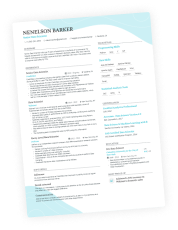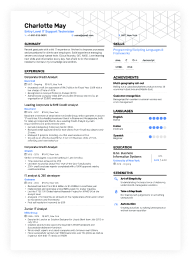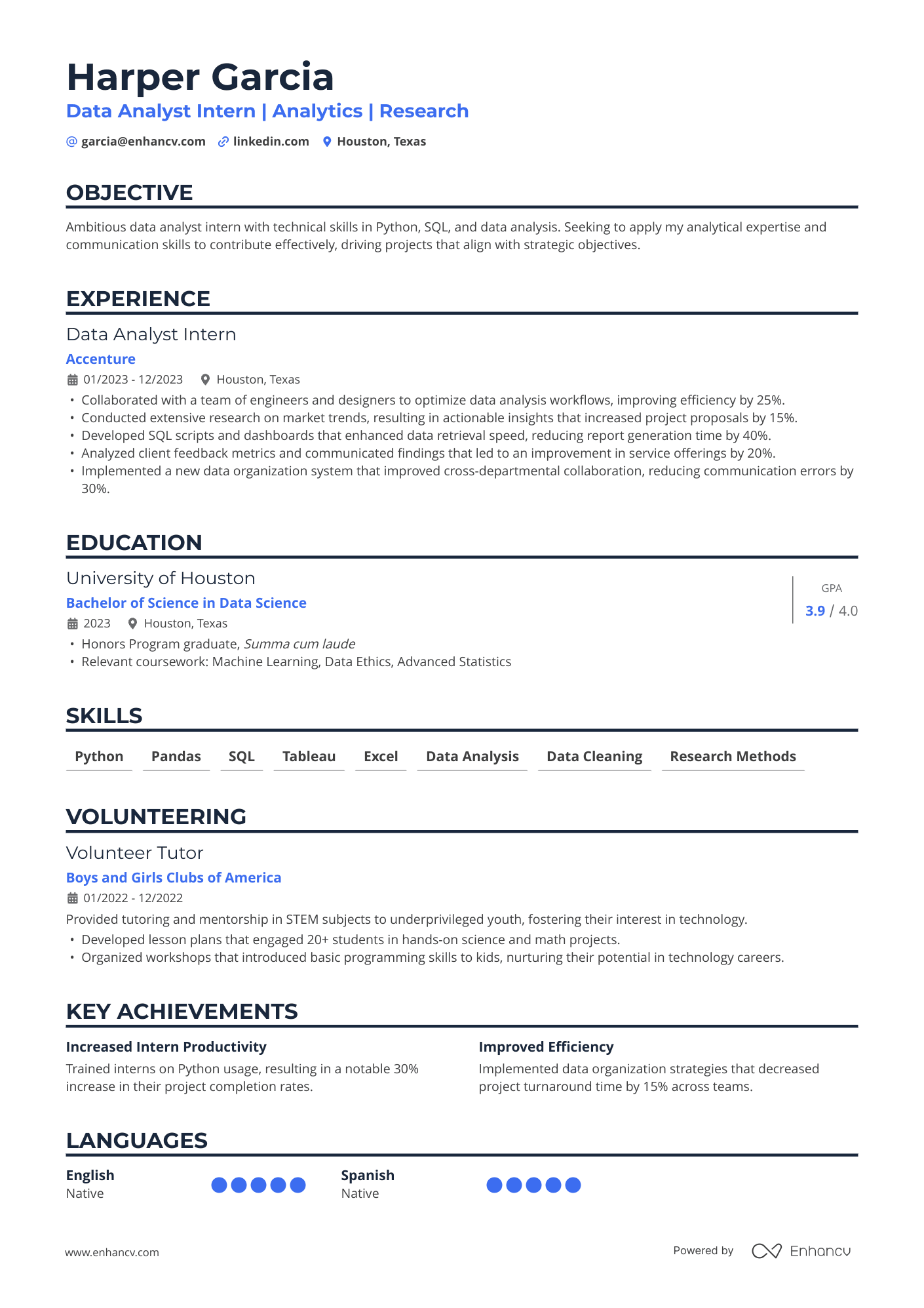Many first-time job seekers wonder whether “graduated with honors” belongs on a resume—and if so, where and how to include it. If you're working with limited experience and trying to build a resume that feels complete, every detail matters.
Academic honors can help, but only if they’re presented clearly and professionally. At Enhancv, we help students and recent grads turn academic recognition into resume value that hiring managers actually notice.
This guide explains how to list “graduated with honors” on your resume, what types of academic achievements count, and how to avoid overloading your education section.
Key takeaways
- Graduating with honors is worth including, especially in early career stages.
- List honors in the education section, or in a separate “Honors & Awards” section if needed.
- Use italics for Latin honors like summa cum laude, and lowercase them unless part of a formal title.
- Skip high school honors once you’ve completed a college degree or gained relevant experience.
- Be specific and honest—never stretch, inflate, or leave honors vague.
Already started your resume? Run it through our free Resume Checker to see how well you're showcasing your academic honors—and everything else.
Is your resume good enough?
Drop your resume here or choose a file. PDF & DOCX only. Max 2MB file size.
What does “to graduate with honors” mean?
Graduating with honors means you completed your degree with a strong academic record, typically reflected by a high GPA. Schools use different terms to recognize this, but the purpose is the same: to highlight consistent achievement over the course of your studies.
In many colleges and universities, honors are labeled using Latin or Greek distinctions like cum laude or Phi Beta Kappa. Each level usually corresponds to a specific GPA range, though criteria vary by institution.
Here’s a breakdown of the most common academic honors in the U.S.—including how they’re awarded and where they typically appear:
Common academic honors in the U.S.
| HONOR TYPE | TYPICAL CRITERIA | WHERE IT’S AWARDED |
|---|---|---|
| Cum laude | GPA around 3.5–3.69 | College / University |
| Magna cum laude | GPA around 3.7–3.89 | College / University |
| Summa cum laude | GPA 3.9+ or top 5% of class | College / University |
| Graduated with honors | GPA meets threshold set by school | High school or college |
| With distinction | GPA-based or departmental recommendation | College / University |
| Dean’s list | High GPA for a single semester (e.g. 3.5+) | College / University |
| National Honor Society | GPA + leadership and service qualifications | College / University |
| Phi Beta Kappa | Invitation-only; top ~10% of arts and sciences students | College / University |
| Honors program graduate | Completion of special coursework or thesis | College / Honors College |
| Valedictorian / Salutatorian | Highest/second-highest GPA in class | High school |
Regardless of how it’s phrased, “Graduated with honors” is a credential worth listing on your resume, especially if you're early in your career and want to make your education stand out.
If you’ve received any kind of academic honor, there’s more than one way to frame it on your resume—and how you phrase it matters. For example, “graduated with highest honors” might translate to summa cum laude, but only if that’s how your school defines it.
The safest move is to use the wording your school used on your diploma or transcript. And whenever possible, connect it to a GPA, honors program, or formal award—something specific that adds clarity. The more vague it sounds, the less weight it carries.
Author’s take
How to list “Graduated with honors” on a resume
If you earned academic honors when finishing your degree, it’s worth including them, especially if you're still building work experience.
Here's exactly how to do it:
Where to list it
Your honors should go in the education section of your resume, directly below your degree and school name. This keeps everything organized and easy to read.
How to format it
Keep it short and professional, using the following tips:
- List academic honors directly below your degree and school name.
- Keep formatting clean and consistent—avoid bold or colors unless your resume design supports them.
- Use proper case: honors should be in lowercase, even if your degree is in title case.
- If you earned multiple distinctions (e.g., honors program + Latin honors), combine them into one line.
- Use bullet points if your resume format supports them, or stack details beneath the degree line.
Look at the three clear examples below:
Example 1: Graduated with honors (general)
- •Graduated with honors
Example 2: Latin honors
- •Graduated summa cum laude
Example 3: Honors for a college graduate
- •Honors College Graduate, magna cum laude
Italics and capitalization for academic honors
Latin honors like cum laude, magna cum laude, and summa cum laude should be written in lowercase and italicized—this reflects both academic tradition and common resume standards.
General honors like Dean’s List can be written in either lowercase (dean’s list) or title case (Dean’s List)—both are acceptable in U.S. resumes, though consistency matters.
Avoid capitalizing generic phrases like “with distinction” or “graduated with honors”, unless part of a formal title or award.
When in doubt, stay lowercase, use italics for Latin honors, and be consistent throughout your resume.
When should you include your honors?
If you're early in your career and don’t have much work experience yet, academic honors can help fill the gap and spotlight your strengths. But that doesn't mean they belong on every resume forever.
Use this as a guide:
Include honors if:
- You’re a student, recent grad, or early-career professional.
- You need to show academic strength in place of job experience.
- The honor is notable (summa cum laude, competitive scholarship, etc.).
Skip honors if:
- You’ve built over five years of relevant work experience.
- They’re buried under more impactful achievements.
- Your education section is no longer central to your resume’s story.
Honors are a tool—use them when they add value, not just because they’re there.
Take a look at an example resume showing how to list “graduate with honors” using Enhancv’s AI Resume Builder.
If you're still in high school or are pre-college, don't worry—graduating with honors can still add weight to your resume.
Here's how to approach it when you're just getting started.
Graduated with honors in high school: What it means and how to list it
When you’re building your first resume, it’s easy to feel like you don’t have enough to show. Maybe you don’t have formal work experience yet, but what you do have—like graduating with honors—can still speak volumes about how you show up, work hard, and follow through.
Honors in high school are signals of consistency, effort, and potential. And they absolutely belong on a high school resume—especially if you're applying for internships, scholarships, or entry-level jobs.
What it typically means:
- You met your school’s GPA threshold for academic excellence (often 3.5+)
- You may have been placed on the Honor Roll, named valedictorian/salutatorian, or inducted into the National Honor Society.
- Some schools use terms like “with distinction” or “high honors.”
To list your academic recognitions properly, use clear formatting and, when possible, bullet points to underscore your successes and make them easier to scan.
Follow the examples below:
Example 1: Graduated with honors (high school)
- •Graduated with honors
- •Honor Roll (all semesters)
- •National Honor Society Member
Example 2: Current high school student with honors
- •Honor Roll (GPA: 3.9)
- •Advanced Placement Coursework
Once you’ve started college or built relevant work experience, it’s usually best to remove your high school from the education section.
Alternative sections to list “graduated with honors”
The most common place to include “graduate with honors” is under Education—but it’s not your only option. Depending on your resume format and how much you want to emphasize your achievements, you can also place it in other sections.
Here are three smart alternatives that keep your resume clean and strategic:
Where to put academic honors
- Honors & Awards: If your resume already has strong work experience or you’ve earned multiple distinctions, group them into a dedicated section. This makes them stand out without cluttering your education entry.
- Achievements or Certifications: If your honors overlap with a program, competition, or selective credential, they may belong in one of these sections instead—especially if they tie into your career goals (e.g., Honors Thesis, STEM scholarships, research awards).
- Cover letter: If your honors are tied to a bigger story—like a rigorous thesis, honors program, or overcoming academic odds—briefly mention them to frame your work ethic or focus. This adds narrative value beyond the bullet points of your resume.
No matter where you list them, be consistent. Don’t scatter related achievements across different sections unless there’s a clear reason.
Common mistakes to avoid when putting academic honors on resumes
Too often, academic honors are overused, misplaced, or just not relevant anymore. If you want yours to work for you, not against you, make sure to avoid these common pitfalls.
What NOT to say when you graduated with honors
- Don’t fake or exaggerate—employers can and do verify honors.
- Don’t confuse GPA with honors—a 3.2 GPA isn’t the same as cum laude.
- Don’t keep honors vague. Instead of “Graduated with academic achievement,” write magna cum laude or specify a scholarship or program.
- Don’t list high school honors if you’ve already completed a college degree.
- Don’t keep them on your resume forever. Once you reach mid- or senior-level roles, academic distinctions lose impact unless they’re truly exceptional.
Final thoughts
Graduating with honors shows you’re someone who commits, performs, and finishes strong. But like anything on a resume, the value lies in how you present it. Use honors strategically—when they add credibility, fill a gap, or show consistency. Format them clearly, place them where they belong, and don’t let them overstay their welcome.
Make one that's truly you.




